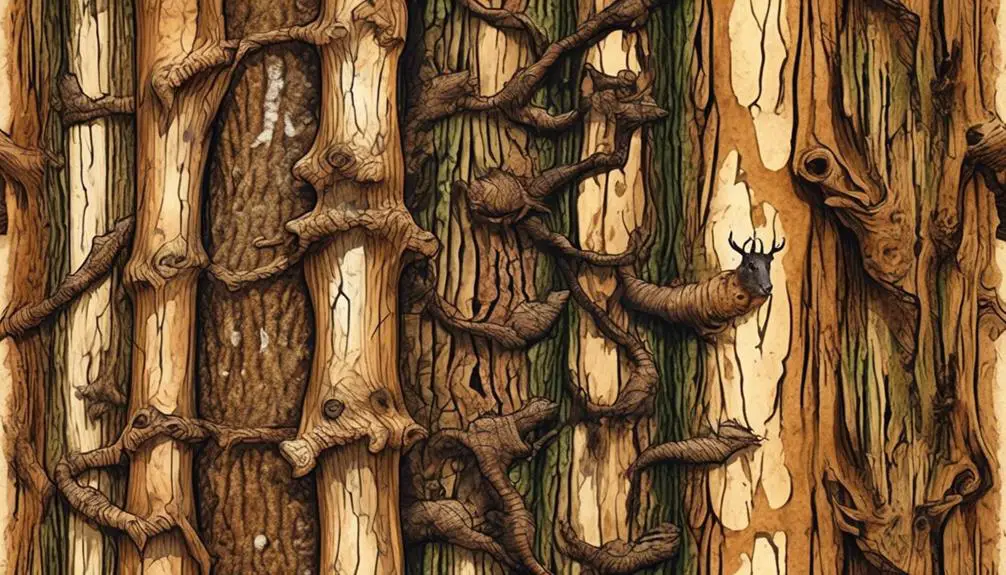Are you curious to uncover the hidden culprits behind the mysterious disappearance of tree bark?
Brace yourself as we embark on a journey to unveil the intriguing world of bark-eating creatures. From the mighty black bears to the nimble squirrels, a wide range of animals have developed a taste for this woody delicacy.
But why do they feast on bark, and what impact does it have on the magnificent trees that grace our landscapes?
Join us as we unravel the secrets of these bark-eating bandits and discover the measures we can take to protect our beloved trees.
Animals That Eat Tree Bark

Black bears, mice and voles, porcupines, rabbits, beavers, mountain beavers, and squirrels are some of the animals that eat tree bark. Bark consumption is a common behavior among these species and serves various purposes.
Black bears, for instance, may strip bark from trees to access the nutritious cambium layer.
Mice and voles, on the other hand, feed on bark for its moisture content during winter when other water sources are scarce.
Porcupines have specialized teeth and digestive systems that allow them to digest the cellulose in bark.
Rabbits consume bark to obtain nutrients and to wear down their continuously growing teeth.
Beavers are known for their bark consumption, which forms a substantial part of their diet and is essential for constructing dams.
Mountain beavers and squirrels also feed on tree bark, although their consumption patterns may vary depending on their specific habitats and dietary requirements.
Understanding the bark-eating behaviors of these animals is crucial for managing and conserving tree populations.
Black Bears Prevention and Control

To prevent and control black bears from eating tree bark, you can start by removing outdoor food sources such as garbage cans and bird feeders.
Additionally, pruning or trimming trees can help deter bears from reaching the bark.
These prevention methods aim to eliminate attractants and create physical barriers that discourage black bears from damaging tree bark.
Food Source Removal
By removing outdoor food sources, you can effectively prevent and control black bears from accessing tree bark as a food source. Black bears are opportunistic feeders and will consume tree bark when other food sources are scarce. To remove their access to tree bark, it’s important to eliminate any potential food attractants in your outdoor spaces.
This includes properly securing garbage cans, removing bird feeders, and cleaning up fallen fruit from trees. Additionally, it’s crucial to store pet food indoors and avoid leaving food scraps or leftovers outside. By removing these food sources, you can significantly reduce the likelihood of black bears being attracted to your property and consuming tree bark.
This proactive approach is key in preventing damage to trees and promoting coexistence with wildlife.
Tree Pruning and Trimming
To effectively prevent and control black bears from accessing tree bark as a food source, a proactive measure to consider is the practice of tree pruning and trimming. By removing low-hanging branches and thinning out dense foliage, you can create a more open and less attractive environment for black bears to climb and access the bark.
Start by identifying the trees that are most susceptible to bear damage and prioritize them for pruning. Trim branches that are within a bear’s reach, typically around 6 feet from the ground. It’s important to make clean cuts and avoid leaving stubs, as this can attract bears.
Regular maintenance is necessary to ensure that the trees remain properly pruned and trimmed, effectively deterring black bears from feeding on tree bark.
Mice and Voles Prevention and Control

Mice and voles can cause significant damage to trees, making it essential to implement effective prevention and control methods. These small rodents have a voracious appetite for tree bark, which can lead to girdling and ultimately the death of the tree.
To prevent mice and voles from damaging your trees, there are several strategies you can employ.
Firstly, packing down the snow line near trees can create a physical barrier that discourages these pests from reaching the bark. By compacting the snow, you make it harder for mice and voles to burrow and access the tree trunks.
Additionally, mowing the lawn in late fall can help reduce the availability of nesting sites for these rodents, further deterring them from your trees.
Another effective method is to place bait stations or mouse traps around the base of vulnerable trees. These traps can be baited with peanut butter or other attractive food sources to lure the mice and voles in.
Using hardware cloth cylinders or physical barriers, such as tree guards or wire mesh, can also prevent these rodents from reaching the bark.
Porcupines Prevention and Control
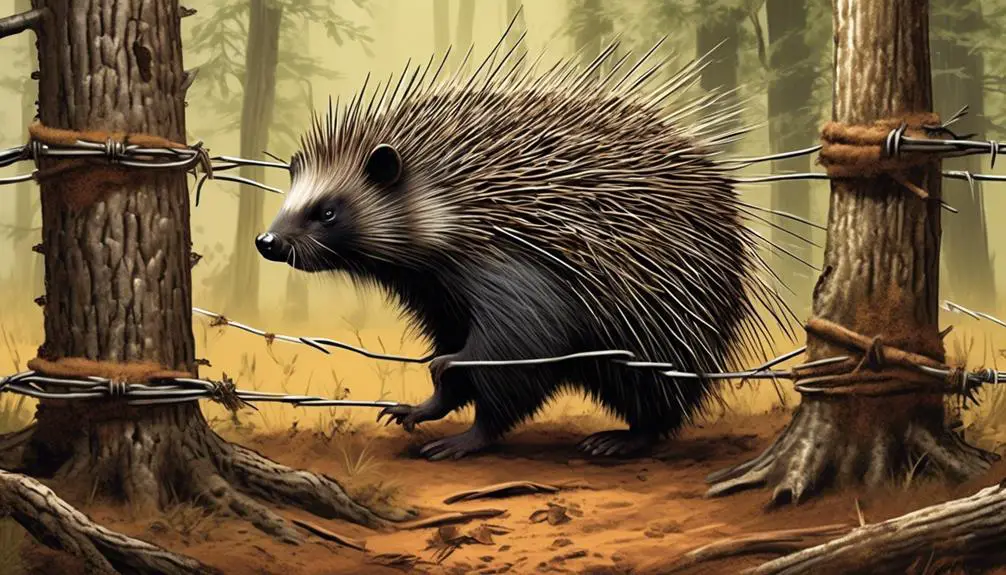
To prevent and control porcupines from damaging tree bark, there are several methods you can employ.
Fencing and traps can be effective in keeping porcupines away from trees, while repellents can deter them from approaching.
Additionally, capturing and releasing porcupines in a more suitable habitat can help mitigate the damage they cause.
Fencing and Traps
Fencing and traps are effective methods for preventing and controlling porcupines from damaging tree bark.
Fencing acts as a physical barrier, preventing porcupines from accessing trees and causing harm. A sturdy fence should be constructed around the tree, extending at least 3 feet above the ground to deter climbing. The fence should be made of a material that porcupines can’t easily chew through, such as metal or heavy-gauge wire.
Traps can also be used to capture porcupines and relocate them away from the area. Live traps, such as box traps or cage traps, should be baited with food that porcupines find enticing, such as apples or corn. Once captured, porcupines should be released in a suitable habitat far away from trees to prevent further damage.
Repellents and Barriers
Porcupines can be deterred from damaging tree bark through the use of repellents and physical barriers.
Repellents can be applied to the tree bark to create an unpleasant taste or smell for porcupines, discouraging them from chewing on the bark. These repellents often contain substances such as capsaicin or garlic oil. It’s important to follow the instructions provided by the manufacturer when applying these repellents.
Physical barriers, such as tree wraps or cylinders made of metal or plastic, can also be effective in preventing porcupines from accessing the tree bark. These barriers should be installed at least 4 feet above the ground to ensure that porcupines can’t reach the bark. Regular inspection and maintenance of the barriers may be necessary to ensure their effectiveness.
Capture and Release
One effective method for preventing and controlling damage to tree bark caused by porcupines involves the capture and release of these animals. Porcupines can cause significant harm to tree bark, which can lead to tree decline and death.
To capture porcupines, live traps can be set up near the affected trees. These traps should be baited with items such as apples or vegetables to attract the porcupines. Once captured, it’s important to handle the porcupines with care, as they’ve sharp quills that can cause injury.
The captured porcupines should then be released in a suitable habitat away from human settlements and areas with valuable trees. This method allows for the removal of the porcupines causing damage while ensuring their survival in a more appropriate environment.
Rabbits Prevention and Control

To prevent and control rabbit damage to trees, it’s important to implement effective methods that deter these small mammals from stripping the bark.
Rabbits can cause significant harm to trees by gnawing on the bark, which can lead to the tree’s decline or death.
One method of prevention is to install a small fence or cylinders under the ground around the tree. This physical barrier can help keep rabbits away from the tree and prevent them from reaching the bark.
Wrapping the tree trunk with aluminum foil or trunk wrap can also deter rabbits from chewing on the bark. These materials are unpleasant for rabbits to chew on and can discourage them from causing damage.
Using rabbit repellents can be another effective method. These repellents are designed to emit odors or tastes that rabbits find unpleasant, deterring them from approaching the tree.
Additionally, building a separate house for pet rabbits can help prevent them from accessing trees and causing damage.
Beavers Prevention and Control
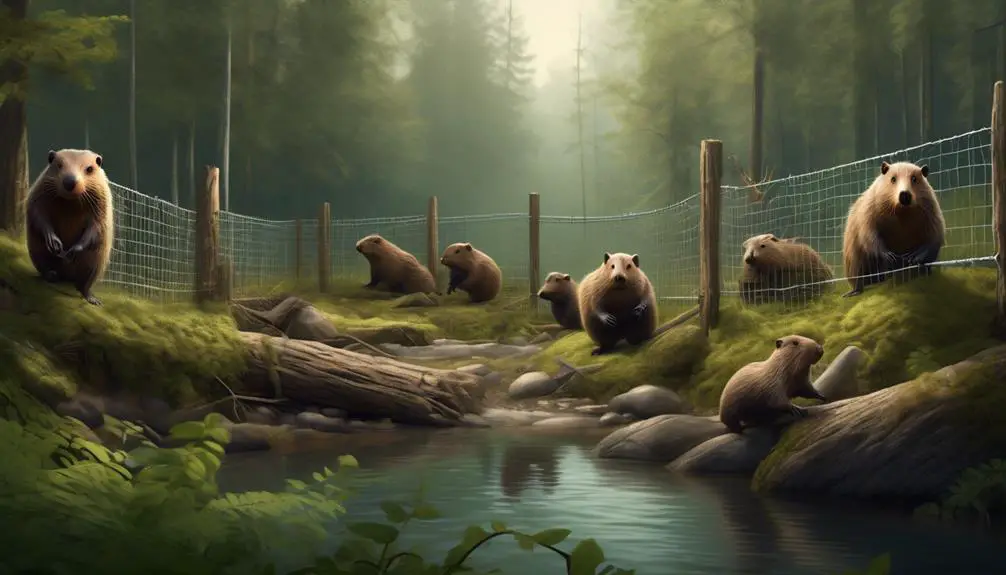
To prevent and control beavers from damaging trees, it’s recommended to build a small fence around the trees to physically block their access.
Additionally, burying hardware cloth cylinders underground can create an underground barrier that prevents beavers from reaching the tree trunks.
Using galvanized and welded wire can also provide protection against beaver damage.
These measures help to safeguard trees from beaver activity and preserve their bark.
Fencing for Beavers
A fence can be an effective method for preventing and controlling beavers from causing damage to trees. When constructing a fence to deter beavers, it’s important to consider their ability to climb and dig.
Beavers are strong swimmers, so the fence should extend into the water to prevent them from accessing the trees. The fence should be at least three feet high above the ground to make it difficult for beavers to climb over. Additionally, burying the bottom of the fence at least one foot deep in the ground will discourage beavers from digging underneath.
Using sturdy materials, such as galvanized and welded wire, will ensure the fence is strong enough to withstand the beavers’ efforts. Regular inspections and maintenance of the fence are necessary to ensure its effectiveness in preventing beaver damage to trees.
Underground Barriers
When implementing preventative measures for beaver damage, one effective approach is the use of underground barriers.
Underground barriers act as physical obstacles to deter beavers from accessing trees and gnawing on their bark. These barriers consist of burying hardware cloth cylinders around the base of trees that are vulnerable to beaver activity. The hardware cloth is made of galvanized and welded wire, which is durable and resistant to beaver gnawing.
The cylinders should extend at least 3 feet above the ground and 1 foot below the ground to ensure proper protection. This prevents beavers from reaching the bark of the trees and causing damage.
Underground barriers are a practical and efficient method for preventing beaver damage and preserving the health and aesthetics of trees in affected areas.
Galvanized Wire Protection
Galvanized wire protection is a highly effective method for preventing and controlling beaver damage to trees. Beavers are known for their ability to chew through tree bark, which can lead to the death of the tree. By using galvanized wire, you can create a physical barrier that prevents beavers from accessing the tree bark. The wire is durable and resistant to corrosion, making it a long-lasting solution. To further enhance the effectiveness of galvanized wire protection, it is recommended to bury the wire underground to prevent beavers from digging underneath it. This method has been proven to be successful in protecting trees from beaver damage, ensuring their survival and health.
| Benefits of Galvanized Wire Protection | ||
|---|---|---|
| Highly effective in preventing beaver damage | Durable and long-lasting | Resistant to corrosion |
Mountain Beavers Prevention and Control
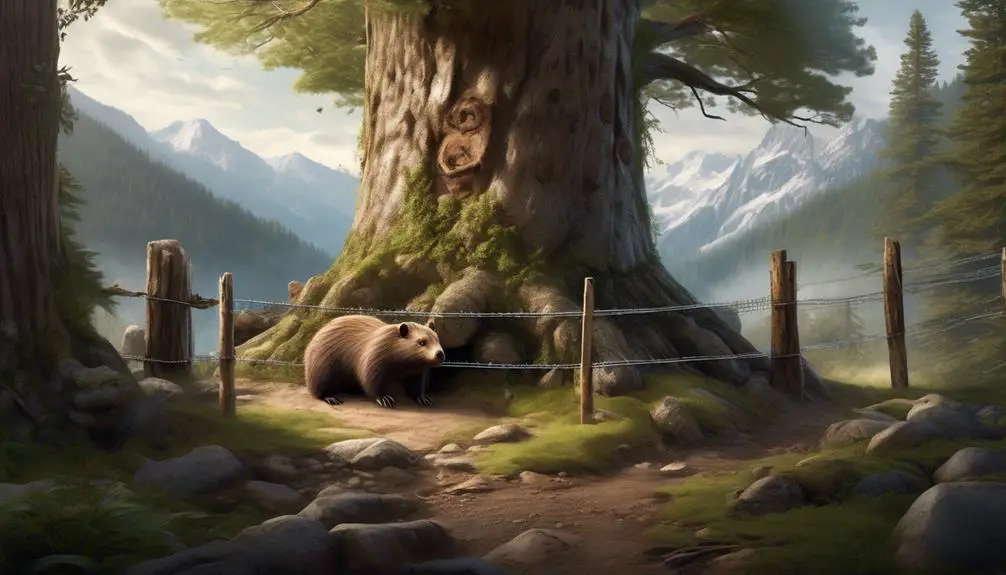
To prevent and control mountain beavers from damaging trees, it’s essential to implement effective methods that deter their feeding behavior.
Mountain beavers, also known as Aplodontia rufa, are herbivorous rodents that primarily feed on the bark and cambium layer of trees. Their feeding activity can cause significant damage to young trees and can even lead to tree mortality.
To prevent this, one method is to create physical barriers around the base of the trees. This can be achieved by using wire mesh cylinders or fencing that extends underground to prevent the mountain beavers from accessing the tree trunk.
Another method is to use repellents that are specifically designed to deter mountain beavers. These repellents can be applied to the bark or foliage of the trees, creating an unpleasant taste or smell that discourages the mountain beavers from feeding. It’s important to note that these repellents should be applied according to the manufacturer’s instructions and in a manner that doesn’t harm the trees or other wildlife.
Additionally, regular monitoring of the trees for signs of mountain beaver activity is important in order to detect and address any potential damage early on.
Squirrels Prevention and Control
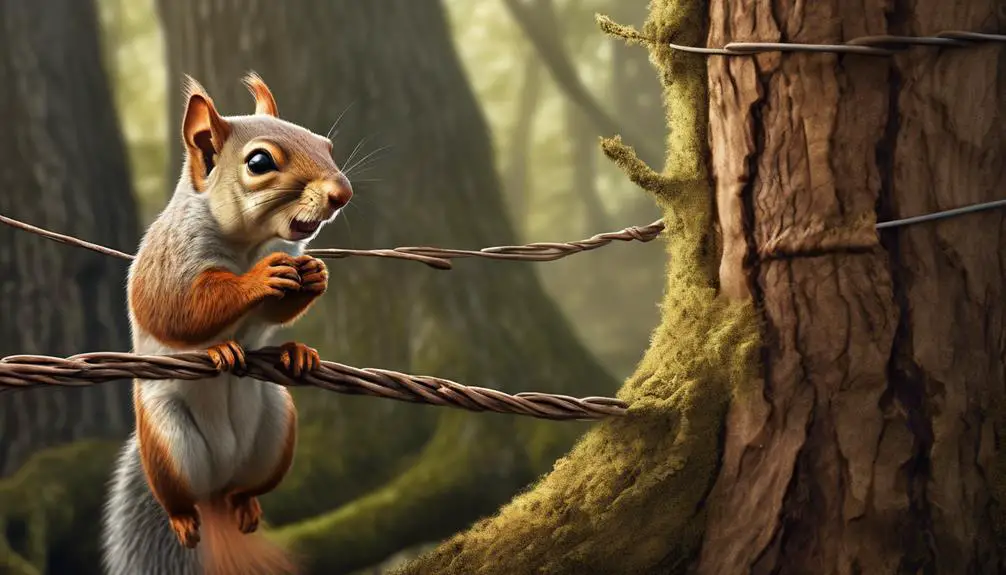
In the realm of preventing and controlling bark-stripping animals, let’s now shift our focus to squirrels. Squirrels, particularly the Eastern gray squirrel and the red squirrel, are known to cause damage to tree bark. They strip the bark to access the sap beneath, which serves as a source of food and moisture.
To prevent and control squirrel damage, several methods can be employed. Firstly, you can wrap the tree trunk with a metal guard or a plastic tree guard, which creates a physical barrier that squirrels can’t easily penetrate. Additionally, you can apply a taste deterrent on the bark, such as a commercial repellent or a homemade mixture of hot pepper or garlic. These substances make the bark less appealing to squirrels.
Pruning overhanging branches near trees can also be effective, as it limits the squirrels’ ability to access the trees. Furthermore, removing fallen nuts or fruit from the ground can discourage squirrels from frequenting the area.
If squirrels persist despite preventive measures, live trapping can be employed. Once trapped, squirrels can be released in a suitable location away from your property. However, it’s important to check local regulations and laws regarding trapping and releasing squirrels.
Prevention and Control Methods for Black Bears

One effective method for preventing and controlling black bear damage is by removing outdoor food sources and implementing pruning or trimming techniques for trees. Black bears are attracted to areas where they can easily access food, such as garbage cans, bird feeders, and fruit trees. By securing these food sources or removing them altogether, you can greatly reduce the likelihood of black bear encounters and damage to trees.
Pruning or trimming trees can also be an effective measure to prevent black bear damage. By removing lower branches or thinning out dense foliage, you can make it more difficult for bears to climb up and reach the tree bark. Additionally, keeping trees well-maintained can help minimize the risk of bark stripping.
To further enhance your understanding, refer to the table below which presents prevention and control methods for various animals that eat tree bark:
| Animal | Prevention and Control Methods |
|---|---|
| Black bears | – Remove outdoor food sources |
| – Implement pruning or trimming techniques for trees | |
| Mice and voles | – Pack down the snow line near trees |
| – Mow the lawn in late fall | |
| – Place bait stations or mouse traps | |
| – Use hardware cloth cylinders or physical barriers | |
| Porcupines | – Build a fence or use traps |
| – Capture and release porcupines | |
| – Use porcupine repellents | |
| Rabbits | – Use a small fence or cylinders under the ground |
| – Wrap the tree trunk with aluminum foil or trunk wrap | |
| – Use rabbit repellents | |
| – Build a separate house for pet rabbits | |
| Beavers | – Build a small fence around trees |
| – Bury hardware cloth cylinders underground | |
| – Use galvanized and welded wire | |
| – Limit tree damage to the height beavers can reach |
Prevention and Control Methods for Mice and Voles

By understanding the prevention and control methods for mice and voles, you can effectively protect your trees from bark damage caused by these small rodents. Mice and voles are known to cause significant damage to tree bark, which can lead to tree decline or death. To prevent bark damage, it’s important to take proactive measures.
One effective method is to pack down the snow line near the base of trees. This prevents mice and voles from tunneling under the snow and accessing the tree bark. Additionally, mowing the lawn in late fall can help remove potential hiding places for these rodents.
Using bait stations or mouse traps is another option. These can be strategically placed near the trees to attract and catch mice and voles. It’s important to regularly check and maintain these traps to ensure their effectiveness.
Physical barriers, such as hardware cloth cylinders, can also be used to protect tree trunks. These cylinders should be buried at least 6 inches deep to prevent rodents from burrowing underneath. They should also extend at least 2 feet above the ground to deter climbing.
Prevention and Control Methods for Porcupines
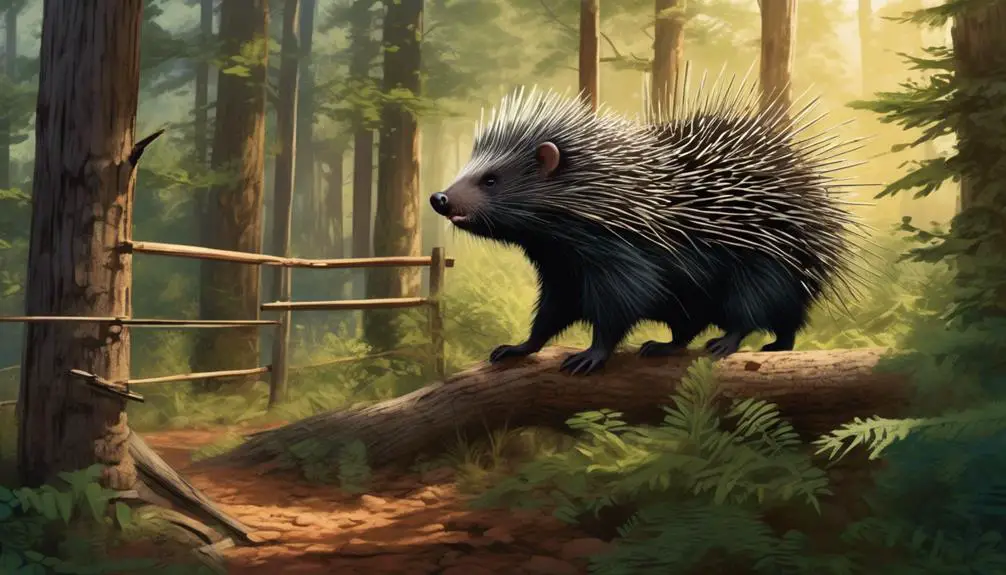
To effectively prevent and control porcupines from causing bark damage to trees, various methods can be implemented. Here are some prevention and control methods for porcupines:
| Method | Description |
|---|---|
| Building a fence or using traps | Erecting a fence around the trees can prevent porcupines from accessing them. Live traps can also be used to capture and relocate the porcupines to a different location. |
| Capturing and releasing porcupines | If a porcupine is already causing damage to trees, it can be safely captured using specialized equipment and released in a more suitable habitat away from trees. |
| Using porcupine repellents | Certain repellents, such as predator urine or commercial repellent sprays, can be applied to the tree bark to deter porcupines from chewing on it. However, the effectiveness of these repellents may vary. |
These prevention and control methods aim to minimize the damage caused by porcupines and promote the health and vitality of trees. It is important to note that porcupines are protected in some regions, so it is essential to check local regulations before implementing any control methods. Additionally, seeking professional advice or assistance from wildlife experts can ensure the humane and effective management of porcupine populations. By implementing these methods, you can safeguard your trees from porcupine damage and maintain the beauty and functionality of your landscape.
Prevention and Control Methods for Rabbits

To prevent rabbits from damaging tree bark, you can use fencing and barriers to physically deter them from accessing the trees.
Installing a small fence or cylinders underground can help protect the base of the tree, while wrapping the trunk with aluminum foil or trunk wrap can create a physical barrier.
Additionally, using rabbit repellents can help deter them from approaching the trees in the first place.
Fencing and Barriers
Using fencing and barriers is an effective method for preventing and controlling rabbit damage to trees. By creating physical barriers, you can protect your trees from rabbits who are attracted to the bark. Here are some prevention and control methods using fencing and barriers:
| Method | Description | Pros | Cons |
|---|---|---|---|
| Small Fence | Install a small fence around the tree to prevent rabbits from accessing the bark. | Provides a physical barrier that rabbits cannot easily bypass. | Requires installation and maintenance of the fence. |
| Underground Cylinders | Bury hardware cloth cylinders around the base of the tree to prevent rabbits from burrowing and reaching the bark. | Offers protection to the roots and prevents rabbits from accessing the trunk. | Requires digging and installing the cylinders. |
| Trunk Wrapping | Wrap the tree trunk with aluminum foil or trunk wrap to deter rabbits from chewing on the bark. | Provides a taste and texture deterrent for rabbits. | Needs to be replaced periodically as the wrapping may deteriorate over time. |
| Rabbit Repellents | Use rabbit repellents on and around the tree to discourage rabbits from approaching and causing damage. | Can effectively deter rabbits and protect the tree. | May require frequent reapplication and can be weather-dependent. |
Implementing these fencing and barrier methods can help safeguard your trees against rabbit damage. Choose the method that suits your needs and ensure proper installation and maintenance for optimal protection.
Natural Repellents
Rabbits can cause significant damage to trees by chewing on the bark, but there are natural repellents that can be used to prevent and control this behavior.
One effective repellent is the use of blood meal. Blood meal is a natural fertilizer made from dried animal blood. Its strong odor acts as a deterrent to rabbits, as they’re repelled by the scent.
Another natural repellent is hot pepper spray. This can be made by combining hot peppers with water and dish soap, and then spraying it onto the tree bark. The spicy taste of the peppers acts as a deterrent for rabbits, discouraging them from chewing on the bark.
These natural repellents can be an effective and environmentally friendly way to protect trees from rabbit damage.
Prevention and Control Methods for Beavers

One effective method for preventing and controlling beavers from causing damage to trees is by building a small fence around the trees. This physical barrier can help protect the trees from beaver activity, as beavers can only harm trees as high as they can reach. In addition to fences, there are other prevention and control methods that can be employed.
Here is a table outlining three different methods for preventing and controlling beavers:
| Method | Description | Effectiveness |
|---|---|---|
| Burying hardware cloth cylinders | Burying a cylinder made of hardware cloth around the base of the tree can prevent beavers from accessing the bark | Highly effective |
| Using galvanized and welded wire | Placing galvanized and welded wire around the base of the tree can create a barrier that beavers cannot easily chew through | Moderately effective |
| Trunk wrapping with metal or plastic | Wrapping the trunk of the tree with metal or plastic can deter beavers from gnawing on the bark | Moderately effective |
These methods can be employed individually or in combination to protect trees from beaver damage. It is important to regularly monitor and maintain these prevention and control measures to ensure their continued effectiveness. By implementing these methods, you can effectively prevent beavers from causing damage to your trees and preserve the health and beauty of your landscape.
Identification of the Animal Responsible for Bark Stripping
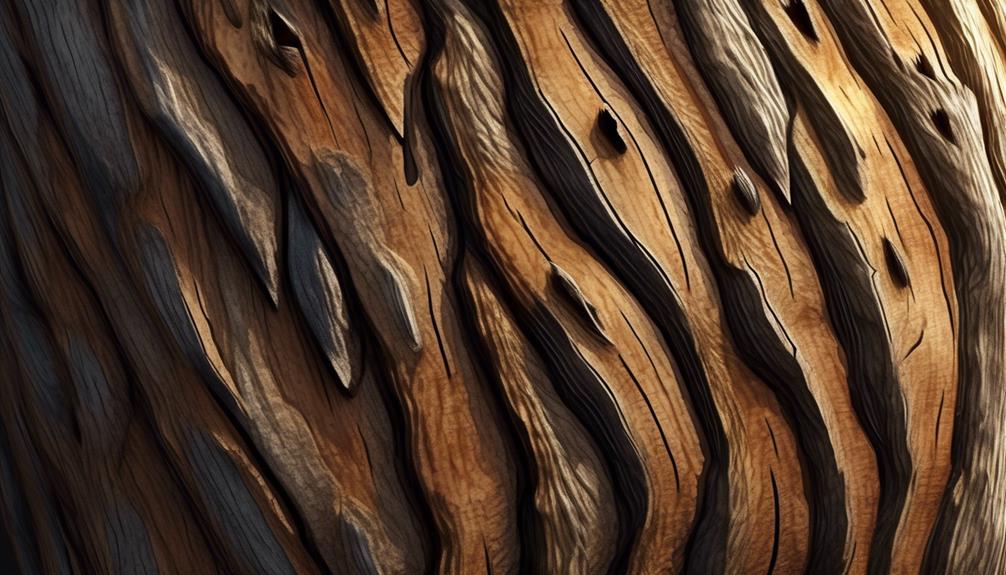
To accurately identify the animal responsible for the bark stripping on trees, a careful examination of the stripped-off bark or patterns on the tree can provide valuable insights. Ripped bark near the ground level, for example, can indicate the presence of rabbits or beavers. Rabbits tend to eat the bark close to the ground, leaving behind a distinctive pattern of gnaw marks, while beavers can strip bark all the way up to their reach, leaving a wider area of damage. By observing the location and height of the stripped bark, you can narrow down the list of potential suspects.
Seasonal factors can also play a role in identifying the culprit. For instance, if the bark stripping occurs during the winter months, mice and voles may be responsible. These small rodents often strip bark during the colder months when food is scarce. Additionally, specific patterns of bark stripping can provide further clues. Porcupines, for example, leave behind a unique pattern of parallel grooves caused by their incisor teeth.

Erzsebet Frey (Eli Frey) is an ecologist and online entrepreneur with a Master of Science in Ecology from the University of Belgrade. Originally from Serbia, she has lived in Sri Lanka since 2017. Eli has worked internationally in countries like Oman, Brazil, Germany, and Sri Lanka. In 2018, she expanded into SEO and blogging, completing courses from UC Davis and Edinburgh. Eli has founded multiple websites focused on biology, ecology, environmental science, sustainable and simple living, and outdoor activities. She enjoys creating nature and simple living videos on YouTube and participates in speleology, diving, and hiking.
- WILDLIFE THEMED T-SHIRTS
Cute Hedgehog Embroidered: Love Wildlife, Protect Nature Wildlife conservation tees
$35.00

